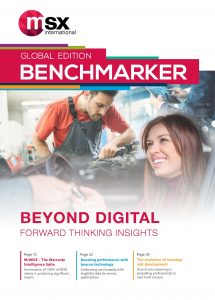M:SCALE
dynamic application development framework
by Tathagata “Teddy” Sarkar, Director of Product Engineering &
Innovation
With companies looking to digitalize many of their operational processes, web applications have become an increasingly important tool for business. Connecting these applications and data sets across the organization is key. MSX’s dynamic application development framework can integrate with an OEMs own business applications and data sets, delivering a solutions that is secure, and produces reports that deliver real business intelligence where it matters most.
New technologies are critical to the automotive industry, helping OEMs to meet the increasingly complex demands of their customers. But managing multiple technologies, supporting all different areas of business, comes with problems of its own. Each solution creates and captures huge volumes of data, but without the right framework in the background, these technologies are inefficient. Each one requires its own development and forms its own data pool, resulting in sizable costs and unmanageable, disparate information. Manufacturers struggle to combine these different data sets, and need a framework that allows them to have a uniform and coherent style of application development and information processing that is easy to extend and manage.
An application framework should support all areas of business. It’s vital an OEM can connect multiple functionalities across different software solutions, so functions can be processed either in a sequence or in parallel. Parallel processing could allow them to process large amounts of data at scale, while sequential processing enables functionalities to be combined into a chain to create a sequence of functionalities.
MSX has developed a solution that adopts these forms of processing. Our application development framework provides a reliable and scalable solution that allows us to develop cloud-based or on-premise solutions that can connect and integrate with OEMs’ own business applications and data sets, delivering value where it matters most.

New technologies are critical to the automotive industry, helping OEMs to meet the increasingly complex demands of their customers. But managing multiple technologies, supporting all different areas of business, comes with problems of its own. Each solution creates and captures huge volumes of data, but without the right framework in the background, these technologies are inefficient. Each one requires its own development and forms its own data pool, resulting in sizable costs and unmanageable, disparate information. Manufacturers struggle to combine these different data sets, and need a framework that allows them to have a uniform and coherent style of application development and information processing that is easy to extend and manage.
An application framework should support all areas of business. It’s vital an OEM can connect multiple functionalities across different software solutions, so functions can be processed either in a sequence or in parallel. Parallel processing could allow them to process large amounts of data at scale, while sequential processing enables functionalities to be combined into a chain to create a sequence of functionalities.
MSX has developed a solution that adopts these forms of processing. Our application development framework provides a reliable and scalable solution that allows us to develop cloud-based or on-premise solutions that can connect and integrate with OEMs’ own business applications and data sets, delivering value where it matters most.
The framework is easy to install and is based on two building blocks.
- Developing distributed functions: Functions are individual pieces of logic that perform one job or achieve one functionality. This is achieved using our framework SDK.
- Joining functions to create processing pipelines: Individual functions can be joined to create complex functionalities or compound functionalities. The functions in a pipeline can be executed in sequence or in parallel for processing high volumes of data.
Using this flexible development model, developers only need to concentrate on building business logic in a standard way and reusing these functionalities by applying them to new business or product use cases. This allows them to quickly and efficiently build and deploy solutions that meet the customer’s needs. For example, a pre-approval engine for a warranty solution can also be used to support technical requirements, a fleet billing solution or the complaints approval functionality within a customer engagement solution. MSX manages all non-functional requirements in the framework, so customers can focus their attention on what they need their systems to do.
The entire M:SCALE framework is based on Kubernetes, an open-source platform for managing containerized workloads, using an actor model based point-to-point protocol (PPP) to link the business logic functions and emulate complex functionality. This provides a distributed system of functions which give the developer the benefit of modelling complex workflows using pipelines.

However, it allows a business to reuse and share more than just functionality. By connecting applications and data across the organization and creating a single integrated view of the information, it unlocks a richer and more mature layer on top of various disparate data systems. Using this, OEMs can work more efficiently, combining their customers’ digital and physical journeys, and improving their communications across multiple retail channels.
It also helps break down the boundaries between business areas, and enables a single customer interaction to serve multiple purposes. For example, an OEM can use one view of data to notify the user of a service requirement via in-car technology, follow up recent warranty work and offer a promotion when the customer is most receptive. The data can also be used to influence the future development of a particular vehicle model. By capturing technical information, including the frequency of common repairs, the manufacturer can make important decisions that improve and enhance vehicle quality and safety.
The solution offers a measurable architecture framework, meaning an OEM can process data and produce reports that deliver intelligence based on strategy, goals and objectives. Its security mechanism relies on permissions-based filters, so OEMs can cascade key business information, mirroring their organizational structure and security hierarchy, confident that they only share reports with the people who should see them.
Failover is also paramount – the effects of system downtime can result in significant losses financially and in terms of productivity. We offer a distributed system framework, allowing data to automatically switch to a standby system in the event of failure or compromise so the impact to the end user is minimal.
Working closely with OEMs, we are overcoming the complexity of integration by building solutions that can be redeployed into other areas of their business. These solutions are forming a future-proof foundation for any new business model and a basis for enhancing performance, cutting costs and increasing profit in today’s dramatically changing automotive industry. And they’re proving that data might make the automotive headlines, but it’s the way its managed that really counts.
 About the Author:
About the Author:
Tathagata “Teddy” Sarkar
Director of Product Engineering & Innovation,
Teddy has a wealth of experience building and managing teams and platforms across global businesses within the automotive industry. He has introduced digital, scalable platforms to support venture development, which include AI, telematics, embedded systems development, big data analytics, distributed systems and parallel computing. With more than 18 years working with some of the largest product organizations in the world, Teddy is now an integral part of the team at MSX’s Digital Innovation Hub in Berlin.
He can be reached at tsarkar@msxi-euro.com
For more insights about MSX, download our latest
Benchmarker 2019





